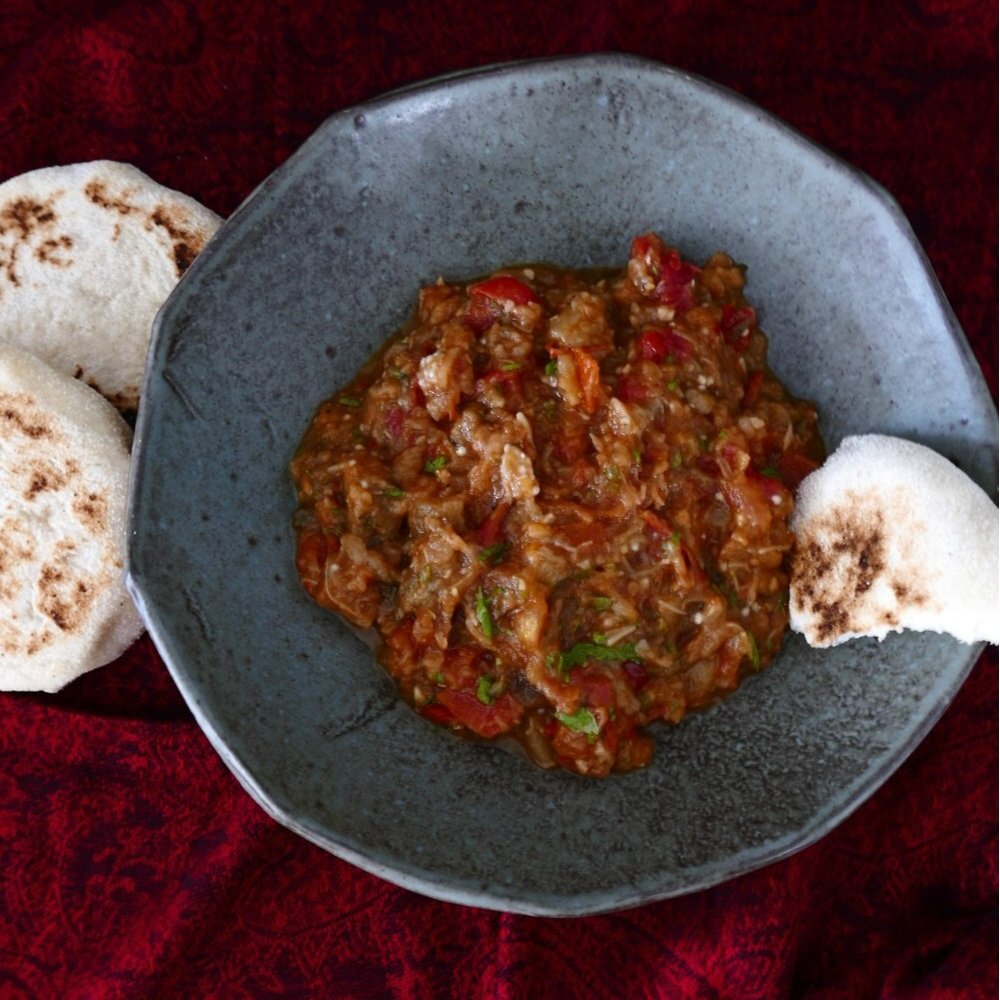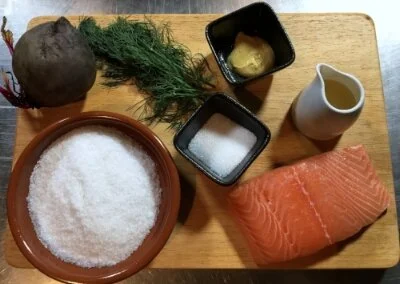explore the world through the universal language of food
Moroccan Zaalouk and Babout
The Recipe
Serves: 3-4 people
Preparation: 10 minutes
Cooking Time: 10-15 minutes
Zalouk is believed to have originated in North Africa, where eggplant and tomatoes are commonly grown. It is thought to have been influenced by the neighboring cuisines of the Mediterranean and the Middle East.
Eggplants are probably one of my favourite vegetables (actually it is a fruit). Thai eggplants, brinjal, aubergine, baby eggplants are so versatile to make salads, dips, curries, stews and this super easy tomato and eggplant salad.
This Moroccan salad is one of my favourite dishes and can be made a few days in advance. Just sit it at room temperature, dress with a bit of oil, lemon and a good side of batbout bread. Batbout is great as it is cooked on the stove so no oven is needed for this recipe! Batbout is even good with butter and honey – it’s reminiscent to and English Muffin of sorts.
THE INGREDIENTS
Zalouk
600g eggplant (1 medium size)
400g really ripe fresh tomatoes, roughly chopped, seeds and skin removed
2-3 cloves of garlic, finely chopped
1 tsp cumin seeds, toasted
1 tsp paprika
½ tsp cumin
½ lemon
1 tsp honey
2 tblsp good olive oil
Chopped flat leaf parsley
Lemon juice and salt to taste
Garnish
Chopped parsley and lemon wedge
THE METHOD
Cook the eggplant over an open fire until the skin is nice and black. You also can use a grill in the oven. Place in a plastic bag and allow it to sweat it out for a bit then peel the skin. Roughly chop and set aside
Lightly fry the garlic and the tomatoes with oil on medium heat.
Add the spices to the tomato as well as honey and eggplant. Cook through for about 10-15 minutes and season with salt and lemon juice. Allow to cool before throwing in parsley leaves.
Eat at room temperature, garnish with extra parsley, olive oil and lemon wedge.
THE RECIPE – BATBOUT
Makes 6 pieces
Preparation time: 15 minutes plus proving time
Cook time: 5 minutes each
THE METHODMix the yeast with sugar and 2 tblsp warm water
Combine the flours and salt in a separate bowl
Add the oil and water to the yeast mixture
Place in an electric mixer with dough hook attachment and mix until combined and smooth
Roll and smooth out. Place in an oiled bowl, cover with cling film and allow to double in size
Turn out the dough and divide into even balls, flatten slightly and roll them in extra semolina
Heat a cast iron fry pan and cook the bread (about a minute each side), or until golden and cooked through
Serve with the delicious salad above
BABOUT
Makes: 6 pcs - Preparation Time: 15 minutes - Cooking Time: 5 minutes each
THE INGREDIENTS
1.5 tsp instant yeast
1 tsp caster sugar
150g plain flour
100g semolina
120-150mls water
1 tblsp olive oil
THE METHOD
Mix the yeast with sugar and 2 tblsp warm water
Combine the flours and salt in a separate bowl
Add the oil and water to the yeast mixture
Place in an electric mixer with the dough hook attachment and mix until combined and smooth.
Roll and smooth out. Place in an oiled bowl, cover with cling film, and allow to double in size
Turn out the dough and divide it into even balls, flatten slightly, and roll them in extra semolina.
Heat a cast iron fry pan and cook the bread (about a minute on each side), or until golden and cooked through.
Serve with the delicious salad above.
Beetroot Salmon
The Recipe
Serves: 6 people
Preparation: Overnight
Assembly: 10 minutes
Amongst a slathering of cream cheese squeezed with some good rye or a spongy bagel, who doesn't like a bit of cured salmon?
This old school way of preserving fish dates back to the middle ages - this is known as gravlax and finds it's origins in Nordic countries such as Finland, Sweden, Denmark and Iceland. The Nordic fisherman used to bury salted and fermented salmon in sand.
However, the actual process of curing fish is known to have begun 3000 BCE, Mesopotamia where salt and sesame oil was used in the process. As Phoenicians started trading salt, it became commonplace in the Mediterranean so the Greeks and Romans began developing their own methods of curing fish, meat and developing some pickling methods.
The idea of curing salmon imparts and infuses flavour into the fish while under a heavyweight and the salt brings out the moisture - enabling the fish or meat to be preserved for long periods of time.
This recipe is a quick and easy way to prepare fish without using heat or too much effort. The end result is impressive in colour and surprising in texture...
THE INGREDIENTS
600g salmon, de-boned
10g dill, leaves only
300g sea salt
500g fresh beetroot
100g white wine vinegar
20g dijon mustard
50g white caster sugar
THE METHOD
Peel and cut beetroot into rough cubes
Blend the beetroot with mustard and white wine vinegar until it makes a nice paste, set aside
Blend the salt, dill and sugar in a spice grinder or this will work in a blender as well
Line a tray with 2 layers of cling film
Line the cling film with half the amount of beetroot mixture and half the amount of the dill salt mixture
Place salmon on this mixture and then pour the remainder of the salt and beetroot on top of the salmon
Wrap the salmon firmly with cling film.
Place in a box and place a considerable amount of weight on the salmon. This will squeeze out extra liquid or moisture from the fish which is ideal for the curing process. Try a few kilograms of flour, wooden boards or containers filled with water.
Store the fish like this overnight
Drain of the excess liquid and wash the salmon well to remove all the salt.
Slice thinly with a very sharp knife
Serve on rye bread with dill, capers, red onions and a good creme fraiche or sour cream








